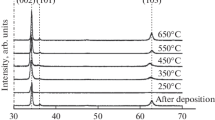Abstract
In this article, the influence of the duration of high-temperature (T = 800 °C) annealing on the transformation of the defective structure and the morphology of thin films from arrays of ZnO nanocrystals synthesized by high-frequency magnetron sputtering was studied using the methods of photoluminescence and atomic force microscopy. On the basis of atomic force microscopy measurements, it was established that ZnO films consist of densely packed grains ranging in size from 40.5 to 49.1 nm. An increase in grain size to statistically significant values over 80 nm is observed as a result of annealing for 60 min. The influence of the high-temperature annealing duration on the transformation of PL spectra of exciton and defects bands and, accordingly, the defect structure of the nanocrystalline ZnO films was determined. In the PL spectra of ZnO nanocrystals, the lines of bound excitons (378 nm, 388 nm) are clearly distinguished in the ultraviolet region. In the visible region, the weak band at 468 nm and fairly intense bands at 559 nm and 683 nm appear, which are characteristic for nanostructured ZnO films obtained by magnetron sputtering. The nature of the specified PL bands is discussed. Differences in the dependence of the intensity of individual PL bands on the duration of annealing are explained by the competition of the recombination mechanisms on non-radiative (Zni) and radiative (OZn, VZn–VO, VZn–2VO) defect centers.




Similar content being viewed by others
Data availability
The authors declare that data supporting the findings of this study are available within the article.
References
C. Jagadish, S. Pearton, Zinc oxide bulk, thin films and nanostructures, in Processing, properties and applications. (Elsevier, Amsterdam, 2006)
A. Tsukazaki, A. Ohtomo, M. Kawasaki, Appl. Phys. Lett. 88, 152106 (2006)
W. Walukiewicz, Phys. Rev. B 50, 5221 (1994)
M.M. Kha, J. Ind. Res. Tech. 1, 135–146 (2011)
A. Dev, A. Elshaer, T. Voss, IEEE. J. Selected Top. Quantum Electron. 17, 896 (2011)
I. Wallace, O.V. Eshu, O.B. Chukwunonso, U.C. Okoro, J. Nanomed. Nanotechnol. 6, 5 (2015)
D.V. Korbutyak, O.G. Kosinov, B.N. Kulchitskiy, Opt. Sem. Techn. 58, 21–45 (2023) (in Ukrainian)
Y. Zhang, T.R. Nayak, H. Hong, W. Cai, Curr. Mol. Med. 13(10), 1633–1645 (2013). https://doi.org/10.2174/1566524013666131111130058]
A. Ortiz-Casas, J. Galdámez-Martínez, A.B. Gutiérrez-Flores, P.K. Ibañez, G. Panda, H.A. de la Santana, M. Vega, C.G. Suar, A. Rodelo, Y.K. Kaushik, A.D. Mishra, Mater. Today (2021). https://doi.org/10.1016/j.mattod.2021.07.025
S. Anjum, M. Hashim, S.A. Malik, M. Khan, J.M. Lorenzo, B.H. Abbasi, Ch. Hano, Cancers (MDPI) (2021). https://doi.org/10.3390/cancers13184570
L. Fedorenko, V. Litovchenko, V. Naumov, D. Korbutyak, V. Yukhymchuk, O. Gudymenko, O. Dubikovskyi, H. Mimura, A. Medvids, Coatings (2022). https://doi.org/10.3390/coatings12111705
H. Cao, R. Chriki, S. Bittner, A. Friesem, N. Davidson, Nat. Rev. Phys. (2019). https://doi.org/10.1038/s42254-018-0010-6
D. Bera, L. Qian, S. Sabui, S. Santra, P.H. Holloway, Opt. Mater. 30, 1233–1239 (2008)
O. Oberemok, V. Kladko, O. Dubikovskyi, O. Kosulya, O. Gudymenko, B. Romanyuk, Z. Maksimenko, T. Sabov, O. Kolomys, Mater. Chem. Phys. (2023). https://doi.org/10.1016/j.matchemphys.2023.127669
A. Galdámez-Martinez, G. Santana, F. Güell, P.R. Martínez-Alanis, A. Dutt, Nanomaterials (Basel) (2020). https://doi.org/10.3390/nano10050857
C.-C. Wang, A.-Y. Lo, M.-C. Cheng, Y.-S. Chang, H.-C. Shih, F.-S. Shieu, H.-T. Tsai, Sci. Rep. 13, 9704 (2023)
P. Rauwel, M. Salumaa, A. Aasna, A. Galeckas, E. Rauwel, J. Nanomater. (2016). https://doi.org/10.1155/2016/5320625
P. Thiyagarajan, M. Kottaisamy, N. Ramaa, M.S. Ramachandra Rao, Scr. Mater. 59, 722 (2008)
K.H. Tam et al., J. Phys. Chem. B 110, 20865 (2006)
S. Vempati, J. Mitra, P. Dawson, Nanoscale Res. Lett.. Lett. 7, 470 (2012)
I. Parkhomenko, L. Vlasukova, F. Komarov, M. Makhavikou, O. Milchanin, E. Wendler, M. Zapf, C. Ronning, J. Phys. D Appl. Phys. (2021). https://doi.org/10.1088/1361-6463/abf0ec
E.V. Kirichenko, V.A. Stephanovich, Sci. Rep. (2021). https://doi.org/10.1038/s41598-021-91414-w
B. Cao, W. Cai, H. Zeng, Appl. Phys. Lett. (2006). https://doi.org/10.1063/1.2195694
Acknowledgements
Not applicable
Funding
No funding was received for conducting this study. The authors have no financial or proprietary interests in any material discussed in this article.
Author information
Authors and Affiliations
Contributions
The manuscript was written through the contributions of all co-authors. All authors contributed to the study conception and design. Material preparation, data collection, and analysis were performed by all authors. The first draft of the manuscript was written by D.V. Korbutyak and all authors commented on previous versions of the manuscript. All authors read and approved the final manuscript.
Corresponding author
Ethics declarations
Conflicts of interest
The authors declare that they have no conflicts of interest.
Ethics approval
The authors declare that the work is written with due consideration of ethical standards.
Consent to participate
All authors of the article agree to participate in the publication.
Consent for publication
All authors of the article agree to participate in the publication.
Additional information
Publisher's Note
Springer Nature remains neutral with regard to jurisdictional claims in published maps and institutional affiliations.
Rights and permissions
Springer Nature or its licensor (e.g. a society or other partner) holds exclusive rights to this article under a publishing agreement with the author(s) or other rightsholder(s); author self-archiving of the accepted manuscript version of this article is solely governed by the terms of such publishing agreement and applicable law.
About this article
Cite this article
Korbutyak, D.V., Lytvyn, O.S., Fedorenko, L.L. et al. Photoluminescence spectra of nanocrystalline ZnO films obtained by magnetron deposition technique. J Mater Sci: Mater Electron 35, 583 (2024). https://doi.org/10.1007/s10854-024-12349-2
Received:
Accepted:
Published:
DOI: https://doi.org/10.1007/s10854-024-12349-2




